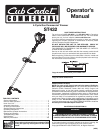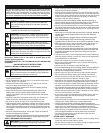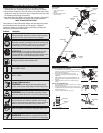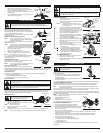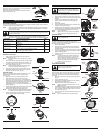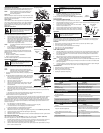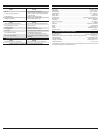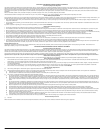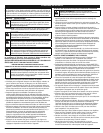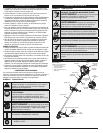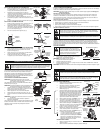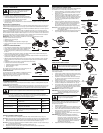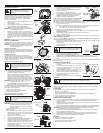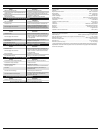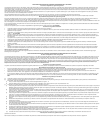
ASSEMBLY INSTRUCTIONS
OIL AND FUEL INFORMATION
RECOMMENDED OIL TYPE
Using the proper type and weight of oil in the crankcase is
extremely important. Check the oil before each use and change
the oil regularly. Failure to use the correct oil, or using dirty oil, can
cause premature engine wear and failure.
Use a high-quality SAE 30 weight oil of API (American Petroleum Institute)
service class SF, SG, SH.
ADDING OIL TO CRANKCASE: INITIAL USE
NOTE: This unit is shipped without oil. In order to avoid
damage to the unit, put oil in the crankcase before
you attempt to start the unit.
Your unit is supplied with one 3.04 fluid oz. (90 ml.) bottle of SAE
30 SF, SG, SH oil (Fig. 6).
NOTE:
Save the bottle of oil. It can be used to measure the correct
amount during future oil changes. See Changing the Oil.
1. Unscrew the top of the bottle of oil and remove the paper
seal covering the opening. Replace the top. Next, cut the
tip off the funnel spout (Fig. 6).
2. Place unit on a flat, level surface.
3. Remove the oil fill plug from the crankcase (Fig. 8).
4. Pour the entire bottle of oil into the oil fill hole (Fig. 7).
NOTE: Never add oil to the fuel or fuel tank.
5.
Wipe up any oil that may have spilled and reinstall the oil fill plug.
Check oil before each use and change as needed. Refer to
Checking the Oil Level.
RECOMMENDED FUEL TYPE
Old fuel is the primary reason for improper unit performance. Be
sure to use fresh, clean, unleaded gasoline.
NOTE: This is a four cycle engine. In order to avoid damage
to the unit, do not mix oil with gasoline.
Definition of Blended Fuels
Today's fuels are often a blend of gasoline and oxygenates such
as ethanol, methanol or MTBE (ether). Alcohol-blended fuel absorbs water. As little as 1% water in the fuel
can make fuel and oil separate or form acids when stored. Use fresh fuel (less than 60 days old), when
using alcohol-blended fuel.
Using Blended Fuels
If you choose to use a blended fuel, or its use is unavoidable, follow recommended precautions:
• Always use fresh unleaded gasoline
• Use the fuel additive STA-BIL® or an equivalent
• Drain tank and run the engine dry before storing unit
Using Fuel Additives
The use of fuel additives, such as STA-BIL® Gas Stabilizer or an equivalent, will inhibit corrosion and minimize the
formation of gum deposits. Using a fuel additive can keep fuel from forming harmful deposits in the carburetor for
up to six (6) months. Add 0.8 oz. (23 ml.) of fuel additive per gallon of fuel according to the instructions on the
container. NEVER add fuel additives directly to the unit's gas tank.
FUELING THE UNIT
1. Remove the fuel cap (Fig. 9).
2. Place the gas container’s spout into the fill hole on the fuel
tank (Fig. 9) and fill the tank.
NOTE: Do not overfill the tank.
3. Wipe up any gasoline that may have spilled.
4. Reinstall the fuel cap.
5. Move the unit at least 30 ft. (9.1 m) from the fueling source and site before starting the engine.
NOTE: Dispose of the old gasoline in accordance to Federal, State and Local regulations.
STARTING/STOPPING INSTRUCTIONS
1. Check the oil level in the crankcase. Refer to
Checking the Oil Level.
2. Fill the fuel tank with fresh, clean unleaded gasoline.
Refer to Fueling the Unit.
NOTE: There is no need to turn the unit on. The
On/Off Stop Control is in the ON ( I ) position
at all times (Fig. 10).
3. Fully press and release the primer bulb 10 times,
slowly. Some amount of fuel should be visible in the
primer bulb and fuel lines (Fig. 11). If you can’t see
fuel in the bulb, press and release the bulb as many
times as it takes before you can see fuel in it.
4. Place the choke lever in Position 1 (Fig. 11).
5. Crouch in the starting position (Fig. 12). Press the
throttle lockout in and squeeze the throttle control
lever. Pull the starter rope 5 times.
6. Place the choke lever in Position 2 (Fig. 11).
7. While pressing the throttle lockout in and squeezing
the throttle control , pull the starter rope 1 to 4 times
to start the engine.
8. Keep the throttle squeezed and allow the engine to
warm up for 15 to 30 seconds.
9. Place the choke lever in Position 3 (Fig. 11). The
unit is ready for use.
IF...
The engine does not start, go back to step 3.
IF...
The engine fails to start after a few attempts,
place the choke lever in Position 3, press the
throttle lockout in and squeeze the throttle control.
Pull the starter rope 3 to 8 times. The engine
should start. If not, repeat.
STOPPING INSTRUCTIONS
1. Release your hand from the throttle control. Allow
the engine to cool down by idling.
2. Press and hold On/Off Stop Control in the OFF (O) position until engine comes to a
complete stop (Fig. 10).
WARNING:
OVERFILLING OIL CRANKCASE MAY CAUSE SERIOUS PERSONAL INJURY.
Check and maintain the proper oil level in the crank case; it is important and cannot be
overemphasized. Check the oil before each use and change it as needed. See Changing the Oil.
WARNING:
Add fuel in a clean, well ventilated outdoor area. Wipe up any spilled fuel
immediately. Avoid creating a source of ignition for spilt fuel. Do not start the engine until
fuel vapors dissipate.
WARNING:
Gasoline is extremely flammable. Ignited vapors may explode. Always stop
the engine and allow it to cool before filling the fuel tank. Do not smoke while filling the
tank. Keep sparks and open flames at a distance from the area.
WARNING:
Remove fuel cap slowly to avoid
injury from fuel spray. Never operate the unit
without the fuel cap securely in place.
STARTING INSTRUCTIONS
WARNING:
Operate this unit only in a well-ventilated outdoor area. Carbon monoxide
exhaust fumes can be lethal in a confined area.
WARNING:
Avoid accidental starting. Make sure you are in the starting position when
pulling the starter rope (Fig. 12). To avoid serious injury, the operator and unit must be
in a stable position while starting.
OPERATING INSTRUCTIONS
HOLDING THE TRIMMER
Before operating the unit, stand in the operating position (Fig. 13).
Check for the following:
• The operator is wearing eye protection and proper clothing
• With a slightly-bent right arm, the operator’s right hand is
holding the shaft grip
• The operator’s left arm is straight, the left hand holding the handle
• The unit is at waist level
• The cutting attachment is parallel to the ground and easily contacts the grass without the need to bend over
ADJUSTING TRIMMING LINE LENGTH
The cutting head allows you to release trimming line without stopping the engine. To release more line,
lightly tap the cutting attachment on the ground (Fig. 14) while operating the trimmer at high speed.
NOTE: Always keep the trimming line fully extended. Line release becomes more difficult as the
cutting line becomes shorter.
Each time the head is bumped, about 1 inch (25.4 mm) of trimming line is released. A blade in the cutting
attachment shield will cut the line to the proper length if excess line is released.
For best results, tap the cutting head on bare ground or hard soil. If line release is attempted in tall grass,
the engine may stall. Always keep the trimming line fully extended. Line release becomes more difficult as
the cutting line becomes shorter.
NOTE: Do not rest the cutting head on the ground while the unit is running.
Some line breakage will occur from:
• Entanglement with foreign matter
• Normal line fatigue
• Attempting to cut thick, stalky weeds
• Forcing the line into objects such as walls or fence posts
TIPS FOR BEST TRIMMING RESULTS
• For best trimming results, operate unit at full throttle.
• Keep the cutting attachment parallel to the ground.
• Do not force the cutting attachment. Allow the tip of the line to
do the cutting, especially along walls. Cutting with more than
the tip will reduce cutting
efficiency and may overload the engine.
• Cut grass over 8 inches (200 mm) by working from top to bottom in small increments to avoid
premature line wear or engine drag.
• Slowly move the trimmer into and out of the cutting area at the desired height. Move either in a
forward-backward or side-to-side motion. Cutting shorter lengths produces the best results.
• Trim only when grass and weeds are dry.
• The life of your cutting line is dependent upon:
• Proper adherence of explained trimming techniques
• What vegetation is cut
• Where vegetation is cut
For example, the line will wear faster when trimming against a foundation wall as opposed to trimming
around a tree.
INSTALL THE CUTTING HEAD SHIELD
1. Place the cutting head shield onto the guard mount
bracket, making sure to align the holes on the shield with
the ones in the guard mount bracket. (Fig. 5)
2. Take the 4 shield screws and screw each one into the shield
until finger tight.
3. Using a Flat Head or T-20 screw driver, tighten the screws
until the shield is firmly in place.
Fig. 7
Funnel
Spout
Fig. 6
Oil Fill Plug
Fig. 8
O-Ring
Oil Fill Hole
Fill Level
Gas Can Spout
Fig. 9
Fuel Cap
Fuel Tank
Fig. 11
Throttle
Control
Fig. 10
Starter
Rope
Fig. 12
Throttle
Control
Start/ On (I)
Stop/ Off (O)
Primer Bulb
Choke Lever
Fig. 13
Fig. 14
4
Fig. 5
Guard Mount
Bracket
Screw (4)
Cutting Head
Shield
WARNING:
Always wear eye, hearing, foot
and body protection to reduce the risk of injury
when operating this unit.
Throttle
Lockout



